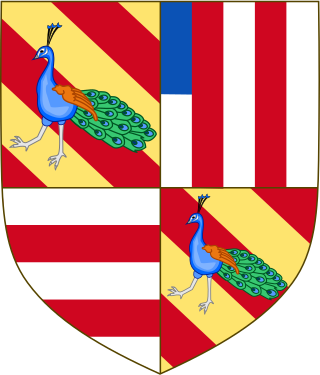Wied-Neuwied was a German statelet in northeastern Rhineland-Palatinate, Germany, located northeast of the Rhine River flanking the northern side of the city of Neuwied. Wied-Neuwied emerged from the partitioning of Wied. Its status was elevated from county to principality in 1784. It was mediatised to Nassau and Prussia in 1806.

The County of Isenburg was a region of Germany located in southern present-day Hesse, located in territories north and south of Frankfurt. The states of Isenburg emerged from the Niederlahngau, which partitioned in 1137 into Isenburg-Isenburg and Isenburg-Limburg-Covern. These countships were partitioned between themselves many times over the next 700 years.
The County of Wied was a territory of the Holy Roman Empire located on the river Wied where it meets the Rhine. Wied emerged as a County earlier than many other German states. From 1243–1462, Wied was united with an Isenburgian County as Isenburg-Wied. Wied was partitioned twice: between itself and Wied-Dierdorf in 1631, and between Wied-Neuwied and Wied-Runkel in 1698. The county was incorporated into the Duchy of Nassau in 1806 and into the Kingdom of Prussia at the Congress of Vienna in 1815. Since 1946, its territory has been part of the German federal state of Rhineland-Palatinate. Via William of Albania, the House of Wied ruled the Principality of Albania in 1914.
Runkel was a German county during the Middle Ages. It held a territory extending from the Lahn river at the town of Runkel northwards past Schupbach. To the south of this territory was the County of Limburg, the County of Hadamar to the northwest, and the County of Weilburg to the west. Also part of the County was an exclave located to the east of Villmar. It was bordered by the County of Limburg to the south and west, and Weilburg to the northeast.

Runkel is a town on the river Lahn in Limburg-Weilburg district in Hesse, Germany.
Moritz Hermann von Limburg, count of Limburg Stirum, was the second reigning count of the branch Limburg-Styrum-Styrum.
William I of Isenburg-Braunsberg was the Count of Isenburg-Braunsberg from 1327 until 1383. In 1338 William was raised to an Imperial Count.
Johann Karl August, Count of Leiningen-Dagsburg-Falkenburg was a German nobleman. By descent, he was Count of Leiningen and Dagsburg, by heritage, he was Lord of Broich and Bürgel.

Prince Christian Everhard of East Frisia was a Prince of East Frisia from the House of Cirksena from the day he was born in 1665, but remained under guardianship until 1690.

Johann Friedrich Alexander of Weid was a German ruler. He was the son of Friedrich Wilhelm of Wied and Luise Charlotte Dohna-Schlobitten. He was Count of Wied-Neuwied from September 17, 1737 to May 29, 1784, when he was elevated to Prince and continued to rule in that capacity until his death on August 8, 1791. He was married to Karoline von Kirchburg. They had three children Frederich Karl of Wied, who succeeded him as Prince, Alexander August of Wied and Sophie Karoline of Wied.
Johanna Sibylla of Hanau-Lichtenberg was the first child of Philipp V, Count of Hanau-Lichtenberg from his first marriage with Countess Ludowika Margaretha of Zweibrücken-Bitsch (1540-1569).
Maximilian Henry, Count of Wied-Runkel was a German nobleman. He was the ruling Count of Wied-Runkel from 1692 until his death.

Runkel Castle, a ruined hill castle from the High Middle Ages, is located in the city of Runkel in the Landkreis of Limburg-Weilburg in the state of Hesse.

Princess Caroline of Nassau-Weilburg was a Princess of Nassau-Weilburg, daughter of Charles Christian, Prince of Nassau-Weilburg and Princess Carolina of Orange-Nassau, wife of Prince Karl Ludwig of Wied-Runkel.

Karl Ludwig Friedrich Alexander, Prince of Wied-Runkel was a German ruler in the Principality of Wied-Runkel from 1791 until 1806 when it was mediatised to the Duchy of Nassau.








